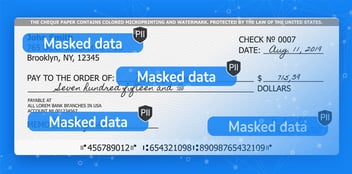Data anonymization erases classified, personal, or sensitive information from datasets, while data masking replaces confidential data with altered values.
Table of Contents
Data anonymization defined
Data masking defined
Data anonymization vs data masking use cases
What’s next for data anonymization and data masking?
Data anonymization vs data masking based on business entities
Data anonymization defined
Data anonymization reduces the risk of sensitive data disclosure – both accidental and malicious – by removing Personally Identifiable Information (PII) from datasets. By doing so, data anonymization tools enable organizations to use their data for wider purposes, without violating various data privacy regulations.
Nearly every organization that needs to collect, store, manipulate, or send sensitive data, uses data anonymization techniques. The solutions that anonymize data are generally configurable – adjusting the level and type of anonymization to the relevant business, data, and applicable regulatory regimes.
One advantage of anonymized data is that it usually remains functionally intact – enabling effective data analysis and manipulation for marketing, customer service, or other uses. At the same time, the sensitive values in an anonymized dataset are irreversibly obfuscated – names, addresses, telephone numbers, etc. Because of this, regulators like the European Union’s General Data Protection Regulation (GDPR) don’t consider a correctly anonymized dataset PII.
Data masking defined
Data masking is the process of hiding sensitive, classified, or personal data from a dataset, by replacing it with equivalent random characters, dummy information, or fake data. This approach essentially creates inauthentic values that preserve the structural characteristics of the dataset itself. Data masking tools allow data to be used for purposes like user training and software testing – protecting the actual sensitive data while offering a fully-functional substitute for organization usage.
Frequently used in organizations where different business domains have different data needs (for example, customer service agents that don’t need to see customer credit card numbers), data masking hides sensitive data on a need-to-know basis – enhancing data security and privacy compliance. It works by substituting PII with randomized values using a variety of different data masking techniques. Because data masking is a reversible process, it’s still considered PII under GDPR.
Get the Gartner report on data anonymization/masking on us.
Data anonymization vs data masking use cases
There are numerous use cases for data anonymization and data masking – many overlapping. Some of the most prominent include:
Data anonymization
-
Facilitating collaboration – When organizations need to share confidential information, privacy considerations can be a huge impediment. For example, if a hospital needs to share medical outcomes with a research institute, the data must first by anonymized – all fields that could possibly identity an individual must be irreversibly obfuscated, while still preserving the integrity of the dataset for research purposes.
-
Enabling insights – Effective data anonymization can help organizations derive insights from customer data, even when customer consent for using their data is not forthcoming. By permanently anonymizing the sensitive values in a dataset, organizations can unlock the value hidden in customer data without violating customer privacy. This enables improved product recommendations, more personalized ads, new product ideas, and enhanced online services and user experience.
-
Reducing financial fraud – Financial services companies are required by regulations like GDPR to obtain customer consent to analyze data – even when the goal of that analysis is mitigation of potentially fraudulent activity. Data anonymization eliminates this hurdle – allowing financial services organizations to better combat fraud without privacy constraints.
-
Improving public policy – Governments are subject to data privacy regulations too. Yet use of data collected about citizens can measurably improve policing and other public policy initiatives. For example, crime can be more effectively predicted using anonymized data gleaned from current crime statistics and social media. Similarly, national statistics offices can make more accurate assessments of public policy issues based on actual – yet anonymized – data.
Data masking
-
Achieving and maintaining compliance – Data privacy regulations like GDPR, HIPAA, GLBA, PCI DSS and others, mandate masking data like PII and other forms of sensitive information, like medical or financial records. To accomplish these goals, sensitive data discovery is the first step.
-
Controlling internal access – Organizations use various types of data masking internally to make sure that staff who don’t require access to sensitive information won’t be able to access it. A simple example of this is masking the last four digits of a credit card number for non-financial staff.
-
Accelerating development – DevOps needs functional datasets for its continuous testing efforts, but manually removing PII can be tedious and time-consuming, which slows version releases. Dynamic data masking allows for faster and more efficient development by enabling shift-left testing and the creation of synthetic test data.
The future of data anonymization and data masking
There is a new generation of data anonymization and data masking solutions that are better able to ensure data privacy and regulatory compliance given today’s complex data structures, hybrid cloud/on-prem environments, and increasingly sophisticated cyberattacks. This new generation of Privacy Enhancing Technologies (PETs) were born of the worlds of encryption, statistics and AI, and include:
-
AI-generated synthetic data, which retains the statistical properties of a dataset without any of the dataset’s original datapoints.
-
Homomorphic encryption, which enables performing analytics on encrypted data without ever decrypting it.
-
Federated learning, which enables Machine Learning (ML) models to be trained and operated locally on devices, so the data doesn’t have to travel.
Anonymization and masking by business entity
Whatever the data anonymization vs data masking verdict, today, the most effective way to safeguard personal or sensitive information relies on data masking technology whose foundation is the business entity.
A business entity can be a customer, device, invoice, or anything else that’s important to the business. All the data associated with a specific entity (a single customer, for example) is stored and accessed from a Micro-Database™. "What's that?" you ask. Think micro data lake in the sense that if your business had a hundred million customers, it would also have a hundred million Micro-Databases (one per customer) instead of one huge data store containing all customer info.
This unique approach leverages intelligent business rules to enhance productivity while ensuring compliance with data protection laws, such as GDPR, regulated by the EU; CPRA, enacted by the State of California; and HIPAA, legislated by the US Congress.
In the age of AI, K2view entity-based tools enable automatic PII discovery using a generative AI Large Language Model (LLM) to profile your data. With a GenAI LLM, you can delve deep into your data, accurately identifying and classifying even the most ambiguous or complex PII.
Discover the exciting world of entity-based data anonymization tools.
















